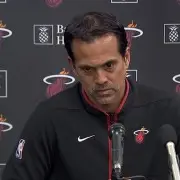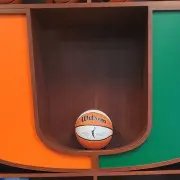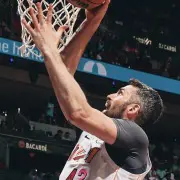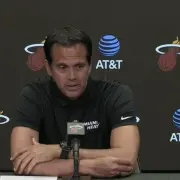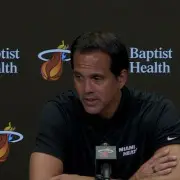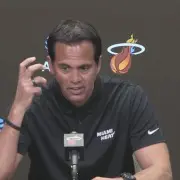Mateo’s Hoop Diary: Heat Crushed in the Fourth Quarter by Knicks
The Heat rolled into Madison Square Garden on a two-game losing streak to face a rival it barely beat on March 22 in Miami. The latest encounter featured 24 lead changes and 14 ties before the New York faithful gave its group a standing ovation.
Jimmy Butler returned to the lineup after missing Tuesday’s loss in Toronto with neck soreness, but Kyle Lowry was absent.
Through the opening period, the Heat logged 36% of its field goal attempts while holding the hosts to eight out of 22 baskets. New York’s quick closeouts in man-to-man coverage to the 3-point line were on time and disruptive, only allowing the visitors three clean looks from deep. Miami’s active hands forced seven turnovers, three being steals in the halfcourt and transition.
In the first frame for the Heat, Gabe Vincent was the lone player to make multiple (3) baskets. First, he nailed a catch-and-shoot triple in the right corner, assisted by the pass and Jimmy Butler’s pindown on Quentin Grimes to prevent the contest. Next, he dropped a fadeaway jumper on the baseline over Jalen Brunson and then a running layup against the seven-foot Mitchell Robinson.
Three early fouls picked up by Max Strus forced coach Erik Spoelstra to shelve him and insert Duncan Robinson. In the first half, Miami’s forgotten specialist logged nearly 15 minutes and canned his three trifectas. Regardless of Vincent and Robinson on target, the rest of the group was inconsistent from the field through 24 minutes.
Before the intermission, the Heatles logged just 14 points in the interior. The Knicks’ length influenced its guests to attack primarily from the outside.
Defensively the Heat was sharp, too, before halftime, but its growing issue was containing Immanuel Quickley. New York’s backup point guard filleted Miami with his speed off the dribble to get to the lane in the halfcourt and transition. Quickley was also active off-ball, relocating when handlers pierced the paint to capitalize on the overhelp. He walked into the locker room at halftime with 14 points on five of eight shots.
Heading into the third quarter, New York held a 48-46 advantage on the scorecard, but where it led decisively was on the glass, beating Miami by eight boards, resulting in 10 second-chance points.
The backline of protection restrained the Knicks from abusing the paint, but the defense up top was disemboweled. The hosts destroyed the 2-3 zone and the weak man-to-man coverage by swinging the ball on the perimeter. New York made six out of 12 triples in the last two quarters.
In the second half, the Heat’s best players didn’t take over when the game was in reach. Bam Adebayo and Jimmy Butler combined in this period to take nine attempts and log a sparse eight points. Vincent contributed 10 additional points, Tyler Herro logged seven and Victor Oladipo nine, but it wasn’t enough. For the 13th time this season, the Heat failed to break 100 points, scoring 92.
Midway through the fourth quarter, Miami’s offense fell apart as New York went on a thundering 8-0 run. The Heat never recovered from that body blow and yielded.
Worse yet for the squad, the Brooklyn Nets defeated the Houston Rockets on the same night, increasing the separation between sixth and seventh place in the East to a game and a half.
All season, the Heat have shown observers who they are- a team that instantly takes a few steps backward after making progress. It’s reminiscent of a college slacker, studying sporadically throughout a semester, or an elected official who only wants to deliver on their promises in an election year.
What this core has accomplished in the past three campaigns means nothing for the last five games on the schedule. As recently as last week, I heard the Cavaliers broadcast say don’t count out Miami. I was perplexed. I can’t imagine anyone who covers the Heat thinking this way because there aren’t any buttons left to smash.
The Heat is an outfit determined to do things the hard way. On March 29, Spo said the Play-In Tournament was “One of the best things that’s ever happened to this league in the last decade…”
He cited throwing a curveball to the middle-of-the-pack teams mimicking the comfort level of the top groups as a reason he favors the play-in. But it seems he’ll deal with it firsthand soon. The Heat’s apathy this late in the season has it destined to be a participant.
On Tuesday, the Miami Herald’s Anthony Chiang pointed out that with the current format of the Play-In Tournament, teams that have passed through it are 0-8 in the first round. The end of the season is near.
Following the fourth-quarter collapse in New York, at the postgame presser, Spo said, “This is where we are. You are what your record is…”
Spo has to see it too.
